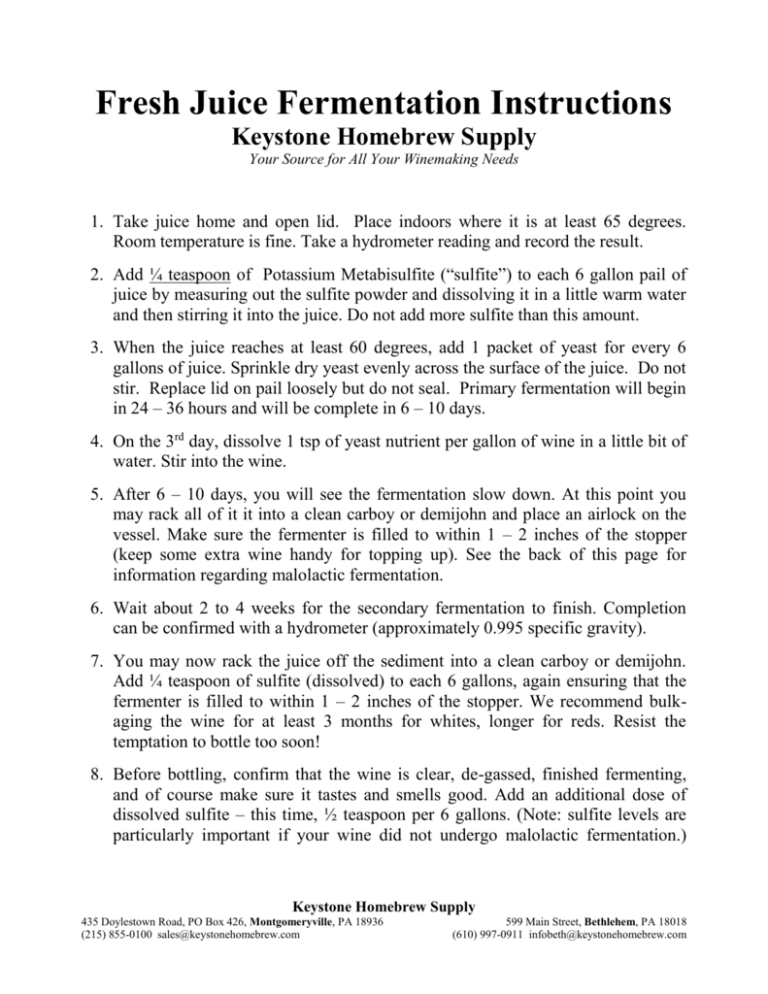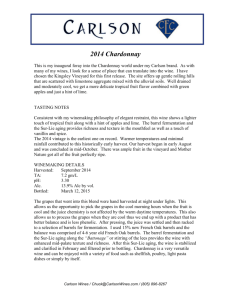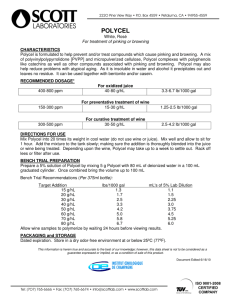Fermentation-Instructions
advertisement

Fresh Juice Fermentation Instructions Keystone Homebrew Supply Your Source for All Your Winemaking Needs 1. Take juice home and open lid. Place indoors where it is at least 65 degrees. Room temperature is fine. Take a hydrometer reading and record the result. 2. Add ¼ teaspoon of Potassium Metabisulfite (“sulfite”) to each 6 gallon pail of juice by measuring out the sulfite powder and dissolving it in a little warm water and then stirring it into the juice. Do not add more sulfite than this amount. 3. When the juice reaches at least 60 degrees, add 1 packet of yeast for every 6 gallons of juice. Sprinkle dry yeast evenly across the surface of the juice. Do not stir. Replace lid on pail loosely but do not seal. Primary fermentation will begin in 24 – 36 hours and will be complete in 6 – 10 days. 4. On the 3rd day, dissolve 1 tsp of yeast nutrient per gallon of wine in a little bit of water. Stir into the wine. 5. After 6 – 10 days, you will see the fermentation slow down. At this point you may rack all of it it into a clean carboy or demijohn and place an airlock on the vessel. Make sure the fermenter is filled to within 1 – 2 inches of the stopper (keep some extra wine handy for topping up). See the back of this page for information regarding malolactic fermentation. 6. Wait about 2 to 4 weeks for the secondary fermentation to finish. Completion can be confirmed with a hydrometer (approximately 0.995 specific gravity). 7. You may now rack the juice off the sediment into a clean carboy or demijohn. Add ¼ teaspoon of sulfite (dissolved) to each 6 gallons, again ensuring that the fermenter is filled to within 1 – 2 inches of the stopper. We recommend bulkaging the wine for at least 3 months for whites, longer for reds. Resist the temptation to bottle too soon! 8. Before bottling, confirm that the wine is clear, de-gassed, finished fermenting, and of course make sure it tastes and smells good. Add an additional dose of dissolved sulfite – this time, ½ teaspoon per 6 gallons. (Note: sulfite levels are particularly important if your wine did not undergo malolactic fermentation.) Keystone Homebrew Supply 435 Doylestown Road, PO Box 426, Montgomeryville, PA 18936 (215) 855-0100 sales@keystonehomebrew.com 599 Main Street, Bethlehem, PA 18018 (610) 997-0911 infobeth@keystonehomebrew.com Common Winemaking Questions Keystone Homebrew Supply Your Source for All Your Winemaking Needs Is my wine fermenting? Hydrometer readings are the best way to monitor the progress of your fermentation. The initial reading will tell you the potential alcohol in the wine. A dry wine should finish near 0.995 on the specific gravity scale. Should I add oak? Oak cubes or chips can add complexity to wine, and are practically essential to many wine styles, imitating the effects of barrel aging. Oak is typically added to wine once it is racked off the sediment following secondary fermentation. The wine should age on the oak for 2 – 3 months or more until the desired level of “oakiness” is achieved. What about malolactic fermentation? Malolactic fermentation can reduce harsh acidity in wine, and is particularly desirable for red wines and sometimes Chardonnays. If you choose to have your wine undergo malolactic fermentation, add the culture immediately following primary fermentation. Do not add sulfite until after the malolactic fermentation is complete (6 to 10 weeks), and maintain a temperature of at least 65 degrees. How can I make sweet wine? You should always allow your wine to ferment to completion (i.e., until there is no residual sugar). If you'd like to sweeten your wine, first be sure to add sulfite each time you transfer your wine to prevent malolactic fermentation. Then, a week before bottling, stabilize the wine with ½ teaspoon of potassium sorbate per gallon, and add sugar (dissolved) to taste. How do I know if I need to make any adjustments to my wine? Although grape juice from California can often produce wonderful wine without any adjustments to acidity, pH, or sugar levels, we always recommend testing these parameters to ensure the high quality and longevity of your wine. Also, although we provide reasonable guideline for sulfite additions, testing your sulfite levels will help you achieve consistently superior results. We sell all the tests you'll need, and we would be happy to show you how to use them. Or sign up for one of our fun and educational winemaking classes! Call our Montgomeryville store for details. Keystone Homebrew Supply 435 Doylestown Road, PO Box 426, Montgomeryville, PA 18936 (215) 855-0100 sales@keystonehomebrew.com 599 Main Street, Bethlehem, PA 18018 (610) 997-0911 infobeth@keystonehomebrew.com







